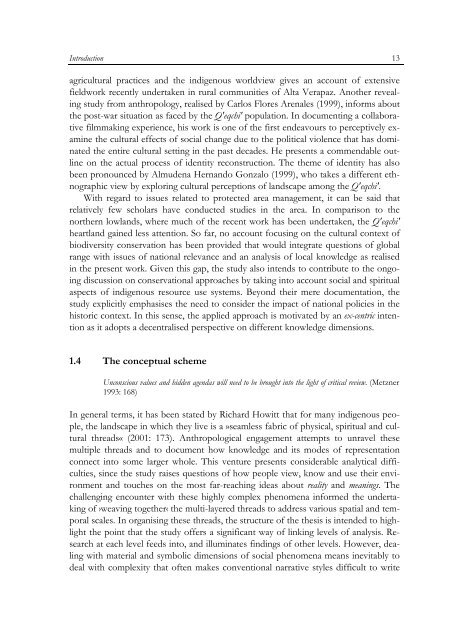The cultural context of biodiversity conservation - Oapen
The cultural context of biodiversity conservation - Oapen
The cultural context of biodiversity conservation - Oapen
Create successful ePaper yourself
Turn your PDF publications into a flip-book with our unique Google optimized e-Paper software.
Introduction<br />
agri<strong>cultural</strong> practices and the indigenous worldview gives an account <strong>of</strong> extensive<br />
fieldwork recently undertaken in rural communities <strong>of</strong> Alta Verapaz. Another revealing<br />
study from anthropology, realised by Carlos Flores Arenales (1999), informs about<br />
the post-war situation as faced by the Q'eqchi' population. In documenting a collaborative<br />
filmmaking experience, his work is one <strong>of</strong> the first endeavours to perceptively examine<br />
the <strong>cultural</strong> effects <strong>of</strong> social change due to the political violence that has dominated<br />
the entire <strong>cultural</strong> setting in the past decades. He presents a commendable outline<br />
on the actual process <strong>of</strong> identity reconstruction. <strong>The</strong> theme <strong>of</strong> identity has also<br />
been pronounced by Almudena Hernando Gonzalo (1999), who takes a different ethnographic<br />
view by exploring <strong>cultural</strong> perceptions <strong>of</strong> landscape among the Q'eqchi'.<br />
With regard to issues related to protected area management, it can be said that<br />
relatively few scholars have conducted studies in the area. In comparison to the<br />
northern lowlands, where much <strong>of</strong> the recent work has been undertaken, the Q'eqchi'<br />
heartland gained less attention. So far, no account focusing on the <strong>cultural</strong> <strong>context</strong> <strong>of</strong><br />
<strong>biodiversity</strong> <strong>conservation</strong> has been provided that would integrate questions <strong>of</strong> global<br />
range with issues <strong>of</strong> national relevance and an analysis <strong>of</strong> local knowledge as realised<br />
in the present work. Given this gap, the study also intends to contribute to the ongoing<br />
discussion on <strong>conservation</strong>al approaches by taking into account social and spiritual<br />
aspects <strong>of</strong> indigenous resource use systems. Beyond their mere documentation, the<br />
study explicitly emphasises the need to consider the impact <strong>of</strong> national policies in the<br />
historic <strong>context</strong>. In this sense, the applied approach is motivated by an ex-centric intention<br />
as it adopts a decentralised perspective on different knowledge dimensions.<br />
1.4 <strong>The</strong> conceptual scheme<br />
Unconscious values and hidden agendas will need to be brought into the light <strong>of</strong> critical review. (Metzner<br />
1993: 168)<br />
In general terms, it has been stated by Richard Howitt that for many indigenous people,<br />
the landscape in which they live is a »seamless fabric <strong>of</strong> physical, spiritual and <strong>cultural</strong><br />
threads« (2001: 173). Anthropological engagement attempts to unravel these<br />
multiple threads and to document how knowledge and its modes <strong>of</strong> representation<br />
connect into some larger whole. This venture presents considerable analytical difficulties,<br />
since the study raises questions <strong>of</strong> how people view, know and use their environment<br />
and touches on the most far-reaching ideas about reality and meanings. <strong>The</strong><br />
challenging encounter with these highly complex phenomena informed the undertaking<br />
<strong>of</strong> ›weaving together‹ the multi-layered threads to address various spatial and temporal<br />
scales. In organising these threads, the structure <strong>of</strong> the thesis is intended to highlight<br />
the point that the study <strong>of</strong>fers a significant way <strong>of</strong> linking levels <strong>of</strong> analysis. Research<br />
at each level feeds into, and illuminates findings <strong>of</strong> other levels. However, dealing<br />
with material and symbolic dimensions <strong>of</strong> social phenomena means inevitably to<br />
deal with complexity that <strong>of</strong>ten makes conventional narrative styles difficult to write<br />
13

















